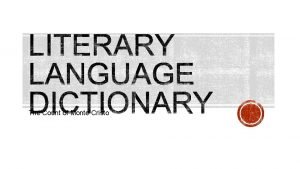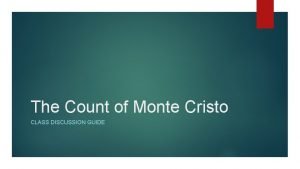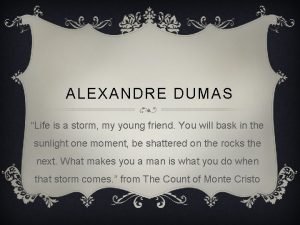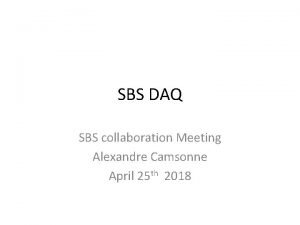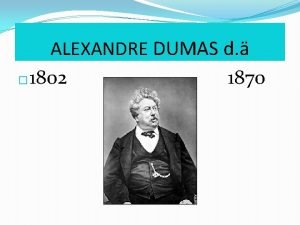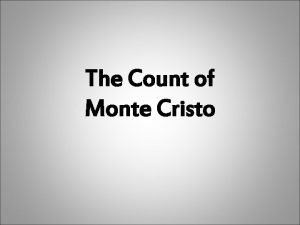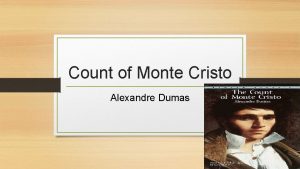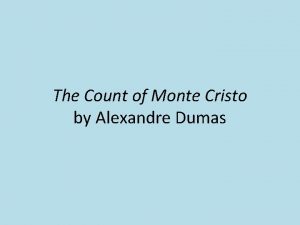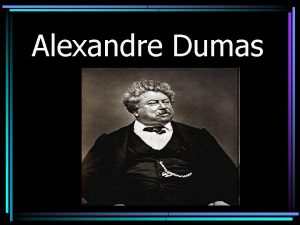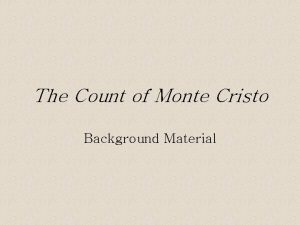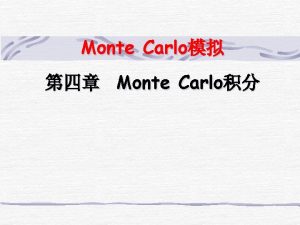The Count of Monte Cristo Alexandre Dumas Meet















- Slides: 15

The Count of Monte Cristo Alexandre Dumas

Meet the Author

Alexandre Dumas One of the most famous French writers of the 19 th century, Dumas is best known for historical adventure novels. n Important works include: The Three Musketeers and The Man in the Iron Mask! n Alexandre was the son of Napoleon’s famous mulatto general Dumas. n Dumas was the son of a French aristocrat and a Haitian black slave. n 1802 -1870

Alexandre Dumas n n At four years of age, Dumas’s father died, and he grew up in poverty; however, loved to read extensively. Stories of his father's brave military acts during the years of Napoleon I of France spawned Dumas’s vivid imagination for adventure and heroes. In 1829 his first solo play, Henry III and his Court, was produced, meeting with great public acclaim. The following year his second play, Christine, proved equally popular, and as a result, he was financially able to work full time at writing. A common practice of the day, Dumas had several collaborators on the majority of his works, none of whom ever received credit.

Alexandre Dumas n n After writing more successful plays, he turned his efforts to novels. Dumas is credited with revolutionizing the historical novel in France. He was also among the first to fully use the serial novel. A serial novel is a single story told in continuous installments that are printed in a newspaper or magazine. The COMC was originally published in 18 installments!

Alexandre Dumas, pere The “Playa” Known as the “King of Paris, ” Dumas earned fortunes and spent them right away on friends, art, and mistresses. In fact, Dumas’ illegitimate son Alexandre Dumas fils was also a famous writer! n Dumas lived as adventurously as the heroes of his books. He took part in the Revolution of July 1830, caught cholera during the epidemic of 1832, and traveled to Italy to recuperate. n Dumas died a pauper, but happy. Dumas suffered a stroke and died on December 5, 1870. n Dumas’s house called The Chateau de Monte Cristo. There is a separate building where Dumas could work privately called the Chateau d’If. Short of money, Dumas had to sell the house after living in it only 2 years. Today it is a museum.

The Count of Monte Cristo A Tale of Justice, Revenge, Mercy, and Forgiveness

The Count of Monte Cristo n The story takes place in France, Italy, islands in the Mediterranean and the Levant during the historical events of 1815– 1838. (This is just after the French Revolution has ended). Marseilles. The first island in the center is the Chateau d’If

Dumas’ Inspiration Dumas got the idea for The Count of Monte Cristo from a true story, which he found in a memoir written by a man named Jacques Peuchet. n The story told of a shoemaker named Pierre Picaud, who was living in Paris in 1807. Picaud was engaged to marry a rich woman, but four jealous friends falsely accused him of being a spy for England. He was imprisoned for seven years. During his imprisonment, a dying fellow prisoner bequeathed him a treasure hidden in Milan. When Picaud was released in 1814, he took possession of the treasure, returned under another name to Paris and spent ten years plotting his successful revenge against his former “friends. ” n This adventure novel takes place between the years of 1815 -1838 which makes the historical setting is a fundamental element of the story. n

The French Revolution 1789 -1799 Noting a downward economic spiral, King Louis XVI brought in financial advisers to review the weakened French treasury. n The advisers noted that a radical change was needed in the way the public was taxed. n King Louis XVI had them kicked out. n

The French Revolution 1789 -1799 Louis XVI convened the Estates. General in May 1789 to discuss the deep financial crisis the French government was experiencing; however, they could not even agree on how voting would proceed once deliberations began. n The bourgeoisie realized they would always be outvoted by the nobility, thus, they walked out of the assembly and established the National Assembly. n They claimed to legitimately represent the people of France. The French Revolution had begun. n

The French Revolution Louis XVI eventually lost his power, and in 1792, he became a prisoner of the common people of Paris when he tried to escape to England. n In 1793, he died at the guillotine. n The son of King Louis XVI, King Louis XVII was proclaimed king but never ruled. He died in prison at the age of 10 after his father’s death. n Allies installed Louis XVI’s brother the next king, Louis XVIII. n

Napoleon vs. Louis XVIII

Napoleon vs. Louis XVIII n n Louis XVIII moves around Europe before settling in England. Napoleon becomes First Consul for Life in 1802 and Emperor of France in 1804. Essentially, he is a dictator. Napoleon went to war with Russia in 1812. Unable to beat the Russians, Napoleon’s weakened army retreated back to France. On April 11, 1814 Napoleon gave up rule of France. He went into exile on the island of Elba.

Napoleon vs. Louis XVIII Trying to reverse many of the results of the French Revolution made Louis XVIII unpopular. n Napoleon made a surprise return to France on March 1, 1815. Joined by his former troops, he again became ruler of France for 100 days. n The struggle for power between Napoleon and Louis XVIII was decided by the Battle of Waterloo with the final overthrow of Napoleon Bonaparte. n
 Personification in the count of monte cristo
Personification in the count of monte cristo Count of monte cristo discussion questions
Count of monte cristo discussion questions The count of monte cristo questions
The count of monte cristo questions Alexandre dumas life is a storm
Alexandre dumas life is a storm Aldi alexandre dumas
Aldi alexandre dumas Sarah bansk
Sarah bansk Sbs alexandre dumas
Sbs alexandre dumas Alexandre dumas uppväxt
Alexandre dumas uppväxt Count of monte carlo
Count of monte carlo Till we meet till we meet at jesus feet
Till we meet till we meet at jesus feet Avanti e dopo cristo
Avanti e dopo cristo Alquimia año 300 a 1550
Alquimia año 300 a 1550 Avanti e dopo cristo
Avanti e dopo cristo Išnyksiu kaip dūmas neblaškomas vėjo
Išnyksiu kaip dūmas neblaškomas vėjo Kjeldahl method calculation example
Kjeldahl method calculation example Patrice dumas
Patrice dumas
